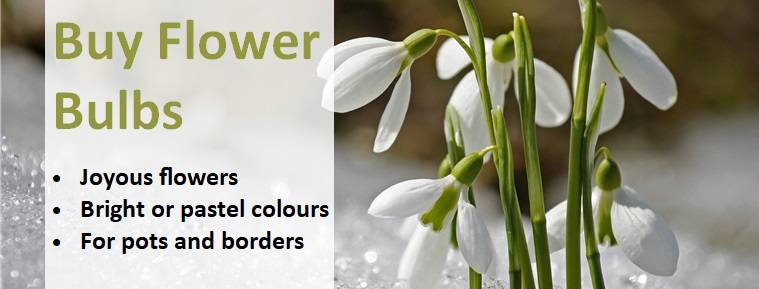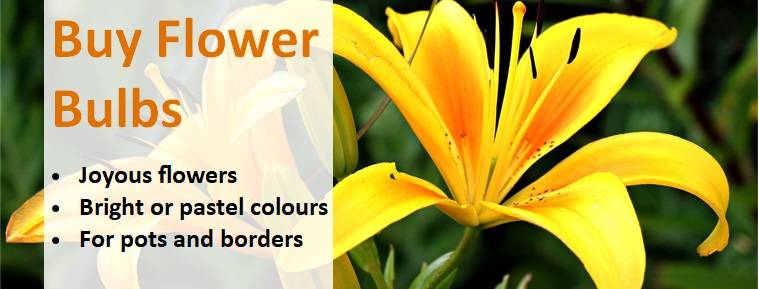Check Here Before Buying – Pot Size Matters...Not all websites offer the same. Plants in a 2-litre pot have twice the root system of a P9 or 1 litre pot.
Where to Plant Bulbs
Bulbs are ideal for bringing fabulous flowers, colour and fragrance to your indoor and outdoor spaces. They can be planted in a wide range of locations including the garden border, flower beds, pots and containers, lawns, long grassy areas, naturalised spaces, formal planting schemes or even shaded areas – yes, you may be surprised but there are even some bulbs that will thrive in shade!
These versatile beauties require a free draining soil to make sure they don’t rot - on heavy clay soils incorporate two buckets of coarse sand per square metre. Plant in individual holes for each bulb or a trench for many bulbs. Bulbs can serve a variety of purposes from complementing existing planting schemes to filling gaps in the border or (for low growing varieties) acting as attractive ground cover.
Growing Bulbs in the Border
- Many bulbs look stunning when planted in bold drifts in borders, such as Fritillaria and Crocosmia. Plant in groups of at least 6 of the same variety for the best display.
- Space them at least twice the bulb’s own width apart to prevent over-crowding.
- Dig a hole wide and deep enough for your bulbs. As a rule of thumb, measure the bulbs from the base to the tip and double or triple this measurement to get a rough idea of the planting depth.
- Place the bulbs in the hole with their growing tip facing upwards.
- Replace the soil and gently firm it, avoid doing this with your feet or too much force as this can damage the bulbs.
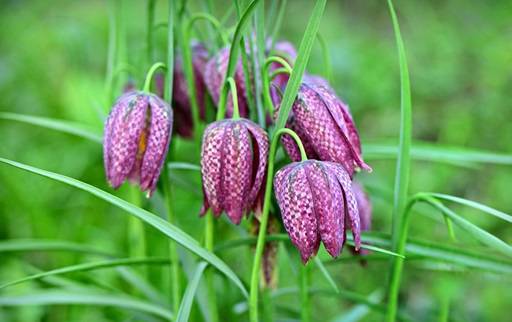
Growing Bulbs in Containers
- Bulbs’ showy flowers make them a popular choice for containers, especially in spots of the garden where you spent a lot of time or pass by often, such as on the patio or along paths.
- Planting up your containers with a specialist bulb compost is usually best, where available. Otherwise, mix a good quality multi-purpose compost with a handful of grit to improve drainage.
- Choose pots with plenty of good drainage holes. Add some broken crocks at the bottom of the pot to prevent the drainage holes getting blocked and your bulbs becoming waterlogged.
- Bulbs can be planted a little closer in a container compared to the border – but avoid planting them at touching distance – spacing at the same width of the bulb’s own width works well.
- Consider the height your bulbs will reach when growing in containers. Tulips look great in pots but anything taller than a typical Fosteriana or Single Early variety may topple over a smaller pot in the breeze.
- If mice and other pests are a problem, cover the top of your pots and containers with chicken wire or mesh until the new shoots appear.
- Pots may need protection from frost during the winter, so wrap the pots with newspaper or horticultural fleece. Clustering several pots together will also help them to stay warm.
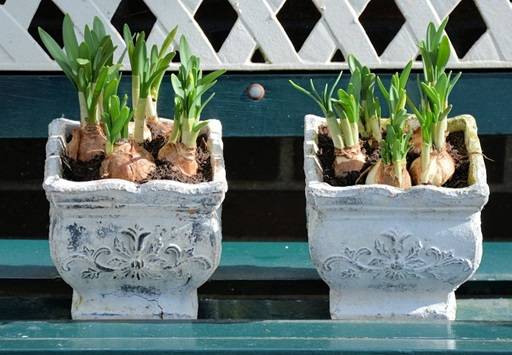
Growing Bulbs in the Lawn
- Bulbs are an excellent way to beautiful an area of lawn whilst maintaining a natural appearance.
- To determine where to plant your bulbs, simply scatter them on top of the lawn. They’ll land in a natural drift, providing an informal display.
- Wherever each bulb lands, dig a hole with a strong trowel and plant according to the required bulb planting depth.
- Replace the soil and gently firm to eliminate air pockets. Avoid treading on this area of lawn as this may result in the bulb becoming damaged.
- If you intend to under-plant larger areas of lawn with bulbs, it may be more efficient to remove the turf and plant the bulbs underneath en masse.
- Be sure to delay mowing your lawn until the flowers have finished and the shoots fully died back. This needs to happen for the goodness to return to the bulb to ensure good growth again next year.
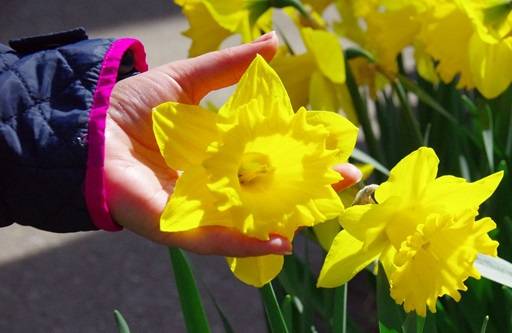
Growing Bulbs in Long Grass
- Certain bulbs like daffodils are well suited to long grass. They’re easy to grow, requiring no care and attention and come in a variety of types for extending the flowering season.
- Early, short-growing types like Puschikinia, Muscari and Chionodoxa are cost effective ways to get some early colour before the grass gets too tall.
- Alternatively, bluebells can be used to create a stunning meadow effect, symbolising that spring has well and truly arrived!
- As your grass starts to grow taller in the summer, later flowering varieties such as Gladiolus, Alliums, Camassia and Byzantinus will complete your meadow-style planting scheme.
- Then for the autumn when the grass has stopped growing, Sternbergia, Cyclamen and Colchicum are effective for continuing the display as other meadow plants start to fade.
Growing Bulbs in Formal Planting Schemes
- Bulbs are not exclusively the domain of informal, cottage style gardens. They absolutely have a place in formal planting schemes too. In fact, tulips planted alongside Buxus topiary or a low box hedge is a popular combination for formal schemes.
- The key to achieving formality with bulbs is very straight rows, using bulbs of uniform height and producing large blocks of matching or contrasting colours.
- The large, globe-shaped flowers of ornamental onions (alliums) can be highly effective for bringing an architectural appearance to formal gardens. They can be grown in relatively tight clumps or grown at equidistant spacing for good results.
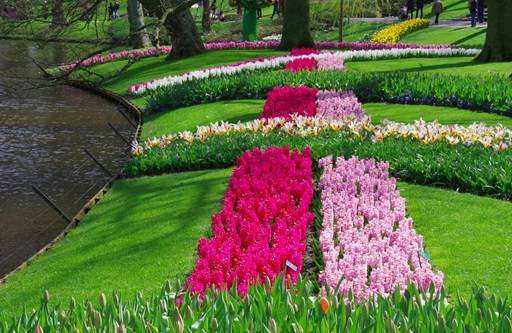
Using Bulbs to Naturalise an Outdoor Space
- Naturalising means planting up an area and then leaving it to its own devices to achieve a natural appearance.
- Plants in naturalised areas should perform well year after year with little or no maintenance. It helps if they represent good value, particularly when naturalising larger areas.
- Good choices for naturalising bulbs are daffodils, bluebells and snowdrops. All will thrive and keep coming back year after year once settled into their new environment.
- Other popular choices are Snake’s Head Lily (Fritillaria Meleagris), Dog’s Tooth Violet (Erythronium) and Winter Aconite (Eranthis).
- Wildflower flower seeds are another great way to develop a large naturalised meadow.
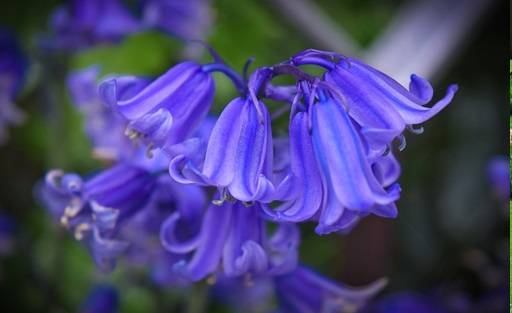
Growing Bulbs in the Shade
- There are some bulbs which will thrive in partial or full shade, perfect if you’re looking to add colour and interest to the shaded areas below deciduous trees where little else will thrive.
- Choosing early flowering bulbs that come to life before the tree canopies come into leaf can also work well in these situations – such as crocus, galanthus, eranthis and early flowering daffodils. However, they may only flower well in the first year as they’ll need sunlight later in the season for the leaves to gather enough energy for the following year’s flowers.
- As other options, English bluebell (Hyacinthoides Non-Scripta), Wood Anemone (Anemone Nemorosa) and Erythronium work well in dappled shade too.
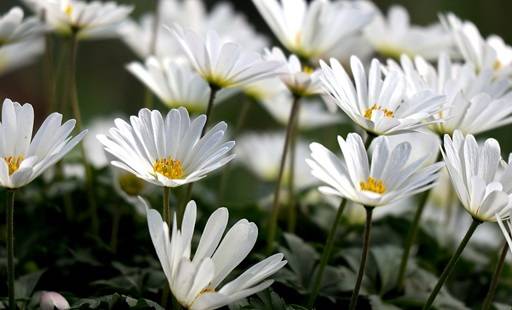
Spring vs. Summer Flowering Bulbs
- Spring bulbs are easy to plant from September to November, rewarding you with a beautiful display of exuberant blooms, giving the first indication that spring is just around the corner!
- Then summer bulbs can be planted in spring, when the soil is beginning to warm up, they’ll require a minimum temperature of 13 degrees Celsius before they’ll start to grow.
- See our guide to different types of flower bulbs for more details.
Want to know more about buying bulbs, when to plant and how to plant, including guidance on planting density and aftercare?
See our full article on how to plant flower bulbs.
Share this page:

